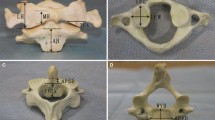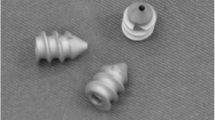Abstract
Objective
To investigate the morphological characteristics of the axis of rheumatoid arthritis (RA) patients with atlantoaxial instability and to determine, by means of sagittal reconstructed computed tomography (CT), the suitability for atlantoaxial transarticular screw fixation.
Design and patients
Twenty-seven patients, who had undergone reconstructed cervical spine CT scanning preoperatively and posterior atlantoaxial arthrodesis for atlantoaxial instability, were identified from a database for inclusion in this study. The isthmus height and internal height of the lateral mass of the axis were measured using digital imaging software.
Results
The mean isthmus height and internal height of the lateral mass of the axis in RA patients (n=14) were significantly lower than in non-RA patients (n=13) (P<0.01). A high-riding vertebral artery (VA) was present in 54% (15 joints, 9 patients) of the 28 atlantoaxial joints in the RA group and in 12% (3 joints, 2 patients) of the 26 atlantoaxial joints in the non-RA group (P<0.01).
Conclusions
In RA patients, the axis showed more extensive thinning of the isthmus and lateral mass than in non-RA patients. A precise preoperative evaluation of screw trajectory using reconstruction CT imaging may be useful in atlantoaxial transarticular fixation, particularly for RA patients with atlantoaxial instability.


Similar content being viewed by others
References
Brooks AL, Jenkins EB. Atlanto-axial arthrodesis by the wedge compression method. J Bone Joint Surg Am 1978;60:279–284
Cornefjord M, Henriques T, Alemany M, Olerud C. Posterior atlanto-axial fusion with the Olerud Cervical Fixation System for odontoid fractures and C1-C2 instability in rheumatoid arthritis. Eur Spine J 2003;12:91–96
Grob D, Magerl F. Surgical stabilization of C1 and C2 fractures. Orthopade 1987;16:46–54
Dickman CA, Sonntag VK. Posterior C1-C2 transarticular screw fixation for atlantoaxial arthrodesis. Neurosurgery 1998;43:275–280; discussion 280–281
Naderi S, Crawford NR, Song GS, Sonntag VK, Dickman CA. Biomechanical comparison of C1-C2 posterior fixations. Cable, graft, and screw combinations. Spine 1998;23:1946–1955; discussion 1955–1956
Farey ID, Nadkarni S, Smith N. Modified Gallie technique versus transarticular screw fixation in C1-C2 fusion. Clin Orthop Relat Res 1999;126–135
Grob D, Dvorak J, Panjabi MM, Hayek J. [Dorsal atlanto-axial screw fixation. A stability test in vitro and in vivo]. Orthopade 1991;20:154–162
Henriques T, Cunningham BW, Olerud C, et al. Biomechanical comparison of five different atlantoaxial posterior fixation techniques. Spine 2000;25:2877–2883
Coric D, Branch CL Jr, Wilson JA, Robinson JC. Arteriovenous fistula as a complication of C1-2 transarticular screw fixation. Case report and review of the literature. J Neurosurg 1996;85:340–343
Goel A, Gupta S. Vertebral artery injury with transarticular screws. J Neurosurg 1999;90:376–377
Prabhu VC, France JC, Voelker JL, Zoarski GH. Vertebral artery pseudoaneurysm complicating posterior C1-2 transarticular screw fixation: case report. Surg Neurol 2001;55:29–33; discussion 33–34
Abou Madawi A, Solanki G, Casey AT, Crockard HA. Variation of the groove in the axis vertebra for the vertebral artery. Implications for instrumentation. J Bone Joint Surg Br 1997;79:820–823
Neo M, Matsushita M, Iwashita Y, Yasuda T, Sakamoto T, Nakamura T. Atlantoaxial transarticular screw fixation for a high-riding vertebral artery. Spine 2003;28:666–670
Casey AT, Madawi AA, Veres R, Crockard HA. Is the technique of posterior transarticular screw fixation suitable for rheumatoid atlanto-axial subluxation? Br J Neurosurg 1997;11:508–519
Wright NM, Lauryssen C. Vertebral artery injury in C1-2 transarticular screw fixation: results of a survey of the AANS/CNS section on disorders of the spine and peripheral nerves. American Association of Neurological Surgeons/Congress of Neurological Surgeons. J Neurosurg 1998;88:634–640
Madawi AA, Casey AT, Solanki GA, Tuite G, Veres R, Crockard HA. Radiological and anatomical evaluation of the atlantoaxial transarticular screw fixation technique. J Neurosurg 1997;86:961–968
Igarashi T, Kikuchi S, Sato K, Kayama S, Otani K. Anatomic study of the axis for surgical planning of transarticular screw fixation. Clin Orthop Relat Res 2003;162–166
Mandel IM, Kambach BJ, Petersilge CA, Johnstone B, Yoo JU. Morphologic considerations of C2 isthmus dimensions for the placement of transarticular screws. Spine 2000;25:1542–1547
Chen TY, Lin KL, Ho HH. Morphologic characteristics of atlantoaxial complex in rheumatoid arthritis and surgical consideration among Chinese. Spine 2004;29:1000–1004; discussion 1005
Song GS, Theodore N, Dickman CA, Sonntag VK. Unilateral posterior atlantoaxial transarticular screw fixation. J Neurosurg 1997;87:851–855
Bloch O, Holly LT, Park J, Obasi C, Kim K, Johnson JP. Effect of frameless stereotaxy on the accuracy of C1-2 transarticular screw placement. J Neurosurg 2001;95:74–79
Paramore CG, Dickman CA, Sonntag VK. The anatomical suitability of the C1-2 complex for transarticular screw fixation. J Neurosurg 1996;85:221–224
Author information
Authors and Affiliations
Corresponding author
About this article
Cite this article
Chung, S.S., Lee, C.S., Chung, H.W. et al. CT analysis of the axis for transarticular screw fixation of rheumatoid atlantoaxial instability. Skeletal Radiol 35, 679–683 (2006). https://doi.org/10.1007/s00256-006-0155-8
Received:
Revised:
Accepted:
Published:
Issue Date:
DOI: https://doi.org/10.1007/s00256-006-0155-8




